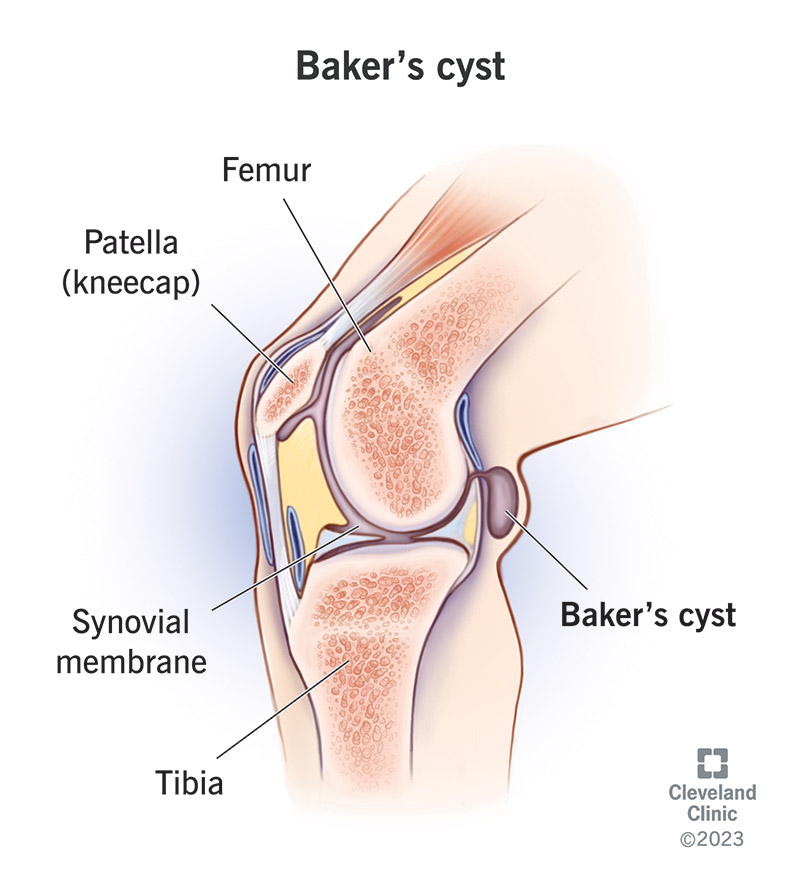Baker’s cysts are small, fluid-filled lumps that form on the back of your knee. They grow after something causes swelling in your knee. They usually aren’t serious. But you should still see a healthcare provider to get it diagnosed. It’s rare, but Baker’s cysts can share symptoms with more serious issues like blood clots.
Advertisement
Cleveland Clinic is a non-profit academic medical center. Advertising on our site helps support our mission. We do not endorse non-Cleveland Clinic products or services. Policy

A Baker’s cyst is a small, fluid-filled bump that forms on the back of your knee. Healthcare providers sometimes call them Baker cysts or popliteal cysts.
Advertisement
Cleveland Clinic is a non-profit academic medical center. Advertising on our site helps support our mission. We do not endorse non-Cleveland Clinic products or services. Policy
They develop when something damages your knee joint or the tissues around it. The damage makes extra fluid drain out of your knee. The fluid can only drain in one direction — out the back of your joint. That buildup forms the sac that becomes a Baker’s cyst.
Popliteal cysts are benign growths. That means they aren’t tumors and are never a sign or symptom of cancer. But visit a healthcare provider as soon as you notice a new growth or lump behind your knee.
The bump that forms behind your knee is the most obvious symptom of a Baker cyst. You might also notice:
You might not experience any symptoms. You may never know you have a popliteal cyst until a healthcare provider notices it during a physical exam.
Anything that damages your knee joint can cause swelling and lead to a popliteal cyst. The most common causes are knee arthritis and injuries.
Arthritis damages tissue in your joints over time. That breakdown can make your body produce extra fluid. Then, the fluid can build up in your knee and become a Baker’s cyst.
Injuries can also lead to Baker’s cysts. The damage from an injury can cause swelling in your knee. That can also lead to fluid buildup which can turn into a cyst.
Advertisement
Anyone can develop a Baker’s cyst. But some people may be more likely to, including:
A cyst can rupture if it fills up too fast or with too much pressure. Picture filling up a water balloon too fast. Too much water or pressure makes the balloon burst. The same thing can happen to a cyst.
A ruptured cyst can cause other symptoms in your knee and lower leg, including:
Baker’s cysts can sometimes cause swelling and discoloration in your lower leg. These can be similar to symptoms of a blood clot. A blood clot is an emergency. See a healthcare provider right away if you think you might have one.
A healthcare provider will diagnose a Baker’s cyst with a physical exam. They’ll examine your leg and look for a lump. Tell your provider when you first noticed the bump and if you’re experiencing any other symptoms. If you hurt your knee, tell your provider what happened.
Your provider might use a few imaging tests to diagnose a Baker’s cyst, including:
Your healthcare provider will treat the cause of the Baker’s cyst. The cyst will usually go away when the damage in your knee that led to it heals. You might need:
Some popliteal cysts go away on their own. But don’t assume anything about a new lump or growth. Visit a healthcare provider. They’ll diagnose a cyst and make sure it’s not something more serious.
Advertisement
It depends on what caused it. Most cysts go away as soon as the swelling gets better. This is usually within a few weeks. Even if you have arthritis, a cyst won’t be permanent.
Your body will reabsorb the fluid as your knee heals. Follow your provider’s suggestions to prevent any more damage.
Picturing a water balloon forming on the back of your knee might make you queasy. But most Baker’s cysts aren’t serious. They sometimes don’t cause any symptoms. And a cyst might even go away on its own.
Make sure you get any new growths on your body checked out. Especially if they appear suddenly or after an injury. Your healthcare provider will help you understand what caused the cyst and how you can help your knee heal.
Advertisement
A Baker cyst can be a minor annoyance or cause a lot of pain, making it hard to move around. Cleveland Clinic’s specialists can help you find relief.

Last reviewed on 07/09/2025.
Learn more about the Health Library and our editorial process.